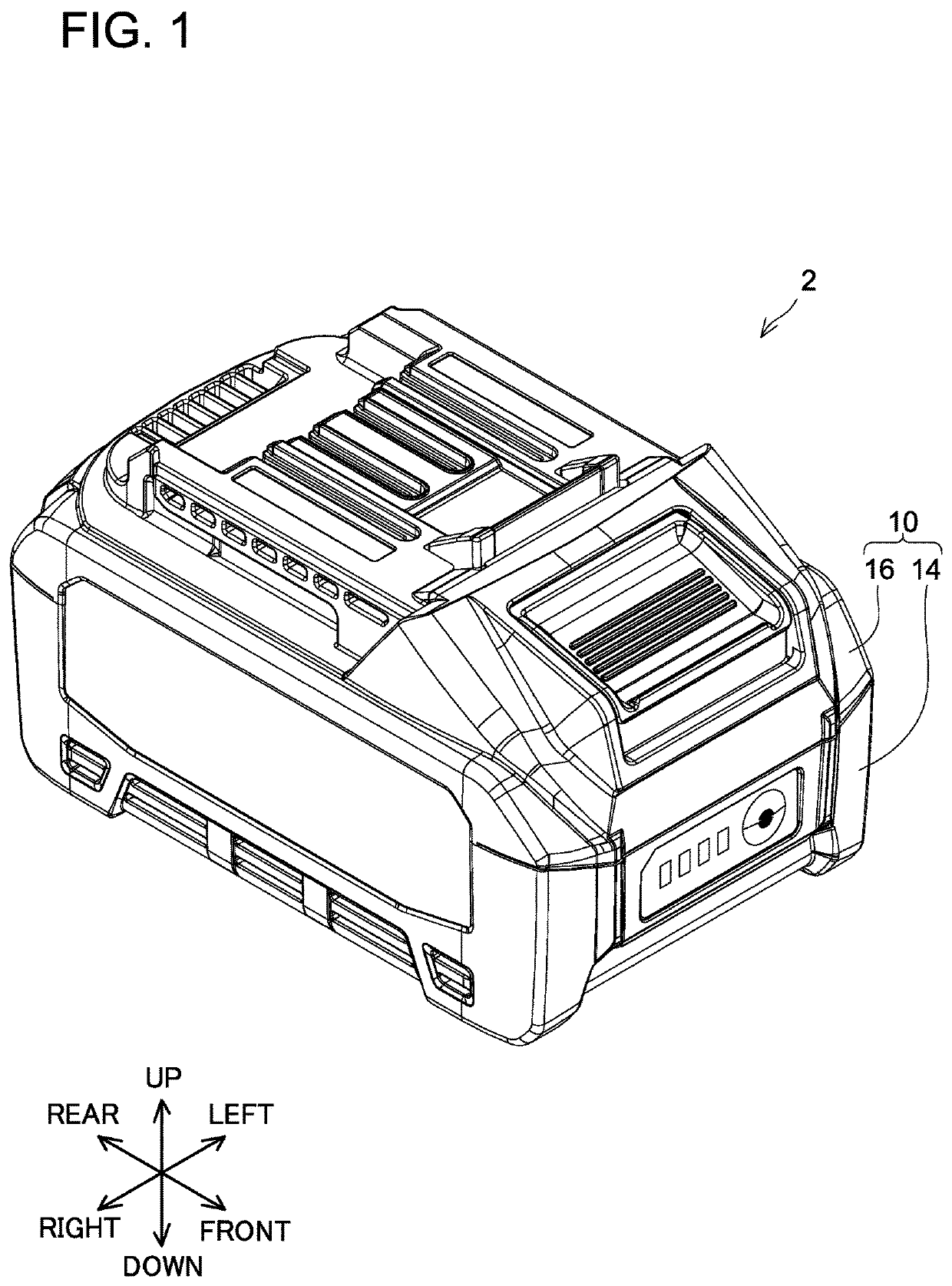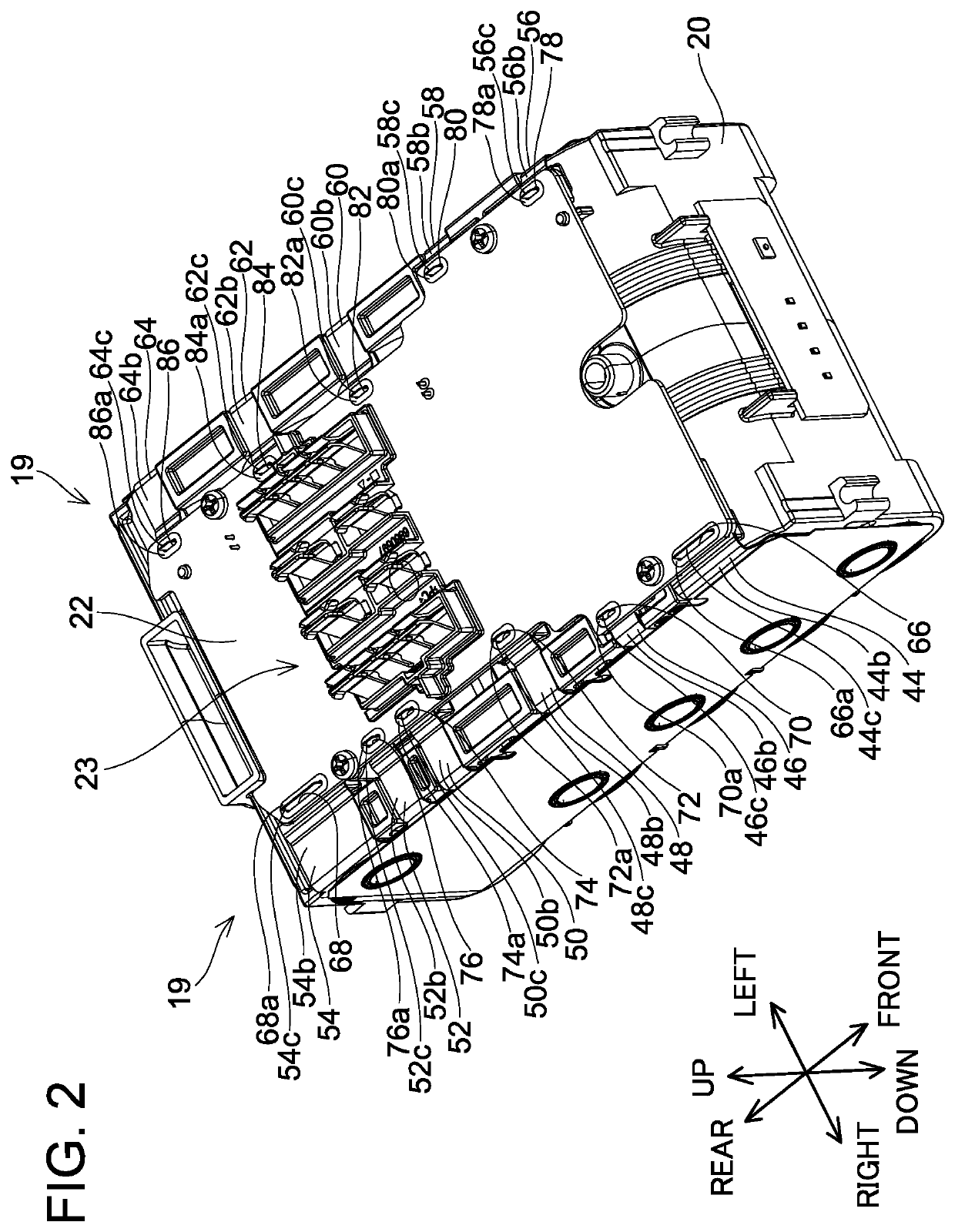Battery apparatus
- Summary
- Abstract
- Description
- Claims
- Application Information
AI Technical Summary
Benefits of technology
Problems solved by technology
Method used
Image
Examples
working example 1
[0055]A battery pack 2 according to the present Working Example 1, which is shown in FIG. 1, is used by being mounted on a battery-pack mount portion (not shown) of electrical equipment (not shown). The electrical equipment may be electrical equipment that runs on electric power supplied from the battery pack 2. The electrical equipment may be, for example, a power tool in which the electric motor of a driver, a drill, or the like serves as the power source, or may be an electric work machine in which the electric motor of a mowing machine (lawn mower), a blower, or the like serves as the power source. Alternatively, the electrical equipment may be electrical equipment that does not have a motor, such as a light, a radio, a speaker, or the like. Alternatively, the electrical equipment may be a charger that supplies electric power to the battery pack 2. The rated (nominal) voltage of the battery pack 2 is, for example, 36 V. The maximum voltage of the battery pack 2 is, for example, ...
working example 2
[0102]A battery pack 202 according to the present Working Example 1, which is shown in FIG. 10, has substantially the same configuration as that of the battery pack 2 of Working Example 1. Hereinbelow, structural elements that are the same as those in the battery pack 2 of Working Example 1 are assigned the same symbols, and detailed explanation thereof is omitted. The rated (nominal) voltage of the battery pack 202 is, for example, 18 V. The maximum voltage of the battery pack 202 is, for example, 20 V. The rated (nominal) capacity of the battery pack 2 is, for example, 4.0 Ah.
[0103]The battery pack 202 comprises the casing (case, housing) 10 and the battery-cell unit 12 (refer to FIG. 11), which is housed in the interior of the casing 10. The casing 10 comprises the lower casing (shell) 14 and the upper casing (shell) 16.
[0104]As shown in FIG. 11, the battery-cell unit 12 comprises: the plurality of battery cells 18 (refer to FIG. 12); the cell holder 20, which is made of a resin ...
modified examples
[0132]The above-described working examples were explained using the battery packs 2, 202 as exemplary embodiments of the battery apparatus of the present teachings; however, the battery apparatus according to the present teachings includes or encompasses other types of battery apparatus, for example, an attachable battery apparatus (portable backpack power supply) in which, for example, shoulder belts, a hip belt, and the like are attached to the battery apparatus so that the user can carry the battery apparatus on his or her back. In such an embodiment, the battery apparatus and the electrical equipment may be electrically connected by, for example, a connection cord (power cord).
[0133]In the above-described embodiments, the battery cell(s) 18 is (are) not limited to having a substantially circular-column shape and may be a so-called rectangular-prism type or may be a laminate type.
[0134]A battery apparatus according to the present teachings may contain a number and type of battery...
PUM
 Login to View More
Login to View More Abstract
Description
Claims
Application Information
 Login to View More
Login to View More - R&D
- Intellectual Property
- Life Sciences
- Materials
- Tech Scout
- Unparalleled Data Quality
- Higher Quality Content
- 60% Fewer Hallucinations
Browse by: Latest US Patents, China's latest patents, Technical Efficacy Thesaurus, Application Domain, Technology Topic, Popular Technical Reports.
© 2025 PatSnap. All rights reserved.Legal|Privacy policy|Modern Slavery Act Transparency Statement|Sitemap|About US| Contact US: help@patsnap.com



